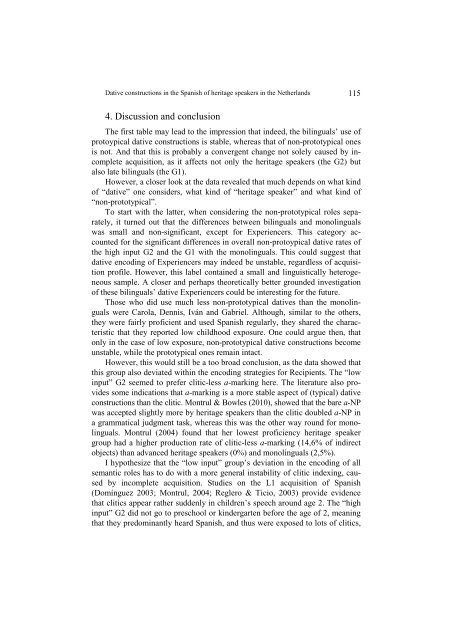s - Wyższa SzkoÅa Filologiczna we WrocÅawiu
s - Wyższa SzkoÅa Filologiczna we WrocÅawiu
s - Wyższa SzkoÅa Filologiczna we WrocÅawiu
You also want an ePaper? Increase the reach of your titles
YUMPU automatically turns print PDFs into web optimized ePapers that Google loves.
Dative constructions in the Spanish of heritage speakers in the Netherlands 115<br />
4. Discussion and conclusion<br />
The first table may lead to the impression that indeed, the bilinguals’ use of<br />
protoypical dative constructions is stable, whereas that of non-prototypical ones<br />
is not. And that this is probably a convergent change not solely caused by incomplete<br />
acquisition, as it affects not only the heritage speakers (the G2) but<br />
also late bilinguals (the G1).<br />
Ho<strong>we</strong>ver, a closer look at the data revealed that much depends on what kind<br />
of “dative” one considers, what kind of “heritage speaker” and what kind of<br />
“non-prototypical”.<br />
To start with the latter, when considering the non-prototypical roles separately,<br />
it turned out that the differences bet<strong>we</strong>en bilinguals and monolinguals<br />
was small and non-significant, except for Experiencers. This category accounted<br />
for the significant differences in overall non-protoypical dative rates of<br />
the high input G2 and the G1 with the monolinguals. This could suggest that<br />
dative encoding of Experiencers may indeed be unstable, regardless of acquisition<br />
profile. Ho<strong>we</strong>ver, this label contained a small and linguistically heterogeneous<br />
sample. A closer and perhaps theoretically better grounded investigation<br />
of these bilinguals’ dative Experiencers could be interesting for the future.<br />
Those who did use much less non-prototypical datives than the monolinguals<br />
<strong>we</strong>re Carola, Dennis, Iván and Gabriel. Although, similar to the others,<br />
they <strong>we</strong>re fairly proficient and used Spanish regularly, they shared the characteristic<br />
that they reported low childhood exposure. One could argue then, that<br />
only in the case of low exposure, non-prototypical dative constructions become<br />
unstable, while the prototypical ones remain intact.<br />
Ho<strong>we</strong>ver, this would still be a too broad conclusion, as the data sho<strong>we</strong>d that<br />
this group also deviated within the encoding strategies for Recipients. The “low<br />
input” G2 seemed to prefer clitic-less a-marking here. The literature also provides<br />
some indications that a-marking is a more stable aspect of (typical) dative<br />
constructions than the clitic. Montrul & Bowles (2010), sho<strong>we</strong>d that the bare a-NP<br />
was accepted slightly more by heritage speakers than the clitic doubled a-NP in<br />
a grammatical judgment task, whereas this was the other way round for monolinguals.<br />
Montrul (2004) found that her lo<strong>we</strong>st proficiency heritage speaker<br />
group had a higher production rate of clitic-less a-marking (14,6% of indirect<br />
objects) than advanced heritage speakers (0%) and monolinguals (2,5%).<br />
I hypothesize that the “low input” group’s deviation in the encoding of all<br />
semantic roles has to do with a more general instability of clitic indexing, caused<br />
by incomplete acquisition. Studies on the L1 acquisition of Spanish<br />
(Domínguez 2003; Montrul, 2004; Reglero & Ticio, 2003) provide evidence<br />
that clitics appear rather suddenly in children’s speech around age 2. The “high<br />
input” G2 did not go to preschool or kindergarten before the age of 2, meaning<br />
that they predominantly heard Spanish, and thus <strong>we</strong>re exposed to lots of clitics,
















